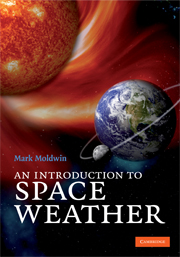Book contents
- Frontmatter
- Contents
- Preface
- Acknowledgments
- 1 What is space weather?
- 2 The variable Sun
- 3 The heliosphere
- 4 Earth's space environment
- 5 Earth's upper atmosphere
- 6 The technological impacts of space storms
- 7 The perils of living in space
- 8 Other space weather phenomena
- Appendix A Web resources
- Appendix B SI units
- Appendix C SI prefixes
- References
- Historical bibliography
- Index
- Plate section
5 - Earth's upper atmosphere
Published online by Cambridge University Press: 05 June 2012
- Frontmatter
- Contents
- Preface
- Acknowledgments
- 1 What is space weather?
- 2 The variable Sun
- 3 The heliosphere
- 4 Earth's space environment
- 5 Earth's upper atmosphere
- 6 The technological impacts of space storms
- 7 The perils of living in space
- 8 Other space weather phenomena
- Appendix A Web resources
- Appendix B SI units
- Appendix C SI prefixes
- References
- Historical bibliography
- Index
- Plate section
Summary
NY Times Headline: WIRELESS SIGNALS ACROSS THE OCEAN; Marconi Says He has Received Them From England. Prearranged Letter Repeated at Intervals in Marconi Code. The Italian Inventor Will Now Leave St. John's, N.F., and Will Go to Cornwall to Continue the Transatlantic Experiments from His Station There.
New York Times. New York, NY, Dec. 15, 1901.Key concepts
satellite radio communication and navigation
ionosphere
aurora
potoionization
Introduction
Earth's upper atmosphere plays an important role in ground-based and satellite radio communication and navigation, and its density determines the lifetime of low-Earth orbiting (LEO) satellites. The upper atmosphere is composed of primarily neutral atoms and molecules in a region called the thermosphere. Within the thermosphere the amount of ionized gas becomes appreciable and forms a region called the ionosphere. The thermosphere and ionosphere overlap in altitude, but because they describe two different particle populations (neutral and ionized), they are often “divided” since what influences the structure and motion of one usually does not necessarily directly drive the other. However, the two populations are coupled through particle collisions (neutral-ion interactions), which means that you usually cannot neglect one or the other. Since the thermosphere-ionosphere system is so important to radio wave propagation and LEO satellite lifetimes, it is one of the crucial areas of study for space weather.
- Type
- Chapter
- Information
- An Introduction to Space Weather , pp. 68 - 78Publisher: Cambridge University PressPrint publication year: 2008



